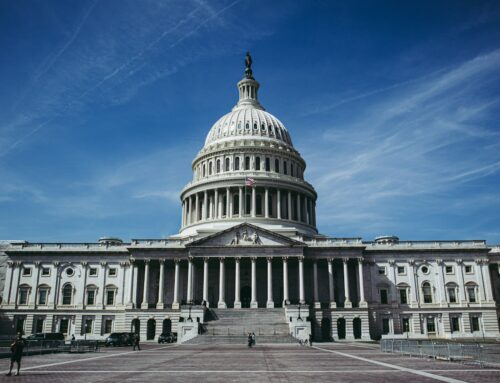After 60 years, the nuclear power industry remains heavily dependent on taxpayer subsidies, faces costly and unresolved waste disposal challenges, and leaves a long trail of ongoing environmental liabilities, from uranium mining contaminants to water pollution.
Host Steve Ellis is joined by TCS Senior Policy Analyst Michael Maragos for a briefing on the money pit situation with small modular nuclear reactors.
Plus, TCS Senior Policy Analyst Wendy Jordan on why the Pentagon shouldn’t be shielded from fiscal and political realities – like agency funding.
Listen here or on Apple Podcasts
Episode 15 – Transcript
Steve Ellis:
Welcome to all American taxpayers seeking common sense. You’ve made it to the right place. For over 25 years. TCS, that’s Taxpayers for Common Sense, has served as an independent non-partisan budget watchdog group based in Washington, DC. We believe in fiscal policy for America that is based on facts. We believe in transparency and accountability because no matter where you are on the political spectrum, no one wants to see their tax dollars wasted.
Steve Ellis:
Shocker. We don’t always get what we want and today, podcast listeners, we’re going to take you inside two prime examples of tax dollars being wasted. Fear not, as you will hear in this episode, there are most certainly ways to turn this around.
Steve Ellis:
We start in the energy sector where after 60 years, the nuclear power industry remains heavily dependent on subsidies, faces costly and unresolved waste disposal challenges, and leaves a long trail of ongoing environmental liabilities from uranium mining contaminants to water pollution.
Steve Ellis:
Here to brief us on the money pit situation with small modular nuclear reactors and the more than $1.2 billion in Department of Energy subsidies to date is TCS own Michael Maragos.
Michael Maragos:
Hey there, Steve. It’s a pleasure to be here.
Steve Ellis:
This is your maiden voyage on Budget Watchdog AF.
Michael Maragos:
That’s right. After a full year I was starting to wonder if I’d ever get the honor.
Steve Ellis:
We wanted to knock out the kinks and make sure that we had a good program for you to start on.
Michael Maragos:
Well, I appreciate that Steve.
Steve Ellis:
Hey, we’re nice like that. So Michael, TCS just released an important report on small modular reactors and the billions still needed to make them potentially commercially viable. After all this time, at taxpayer investment, why are SMRs still so far from market readiness and still so costly?
Michael Maragos:
I think the real question is Steve, why did anyone expect them to be market ready at this point? The undeniable truth of the nuclear energy industry is that it is expensive. From the jump, the huge construction costs that go into nuclear plant were always going to be hard to overcome.
Michael Maragos:
And when this new design, these small modular reactors, which have a capacity of producing about 300 megawatts electric, compared to a standard large scale nuclear reactor which typically produces anywhere from 900 to 1600 megawatts. So it’s considerably smaller design and for that reason, you’re never going to capture economies of scale.
Michael Maragos:
In fact, the thinking is somewhat flipped on its head that by going smaller you can simplify the design and that maybe this way will produce cost effective power. But that’s all really on paper and when these designs for a small modular reactor SMRs were first introduced, there was always going to be a lot of room to go between what was on paper and reality. And so I don’t think it’s any surprise that here we are more than a decade after the department of energy started explicitly funding SMRs and we’re nowhere near commercialization.
Steve Ellis:
How has this SMR technology become the next great hope of the nuclear industry?
Michael Maragos:
The short answer is, its become the next great hope out of desperation. Early on, they tried building reactors bigger and bigger, that is more capacity to produce electricity and they thought that they were going to capture economies of scale. But what ended up happening was, the more complicated plant designs ended up costing a lot more to construct. So they never reached those cost savings. And that’s the reason we actually saw reactor construction die off.
Michael Maragos:
In fact, over a hundred different reactors that had been ordered by different utilities across the country, actually canceled their orders after 1974, 1975. Of the large reactors operating today, the most recent to break ground was in 1978. Gives you an idea of the age of our current nuclear fleet.
Michael Maragos:
There is one current construction project in Georgia, Burke county, Georgia at plant Vogtle, where they’re building two nuclear reactors with a great deal of help from taxpayers. And that project is a case study of why nuclear’s upfront capital costs can be enormous. It’s now more than twice its original budget, which means that instead of $14 billion to construct these two reactors, it’s upwards of $30 billion at this point.
Michael Maragos:
So all of that said, there was this nuclear renaissance that never materialized when it failed to come and nuclear reactors that were big were seen as cost prohibitive. It was kind of out of desperation, the nuclear industry was flailing around for ideas and it said, “All right, we have this other idea over here. Let’s try and build small. Let’s try and modularize it. And maybe that’s the way to overcome all of these difficulties.” It’s the option of last resort because large scale nuclear is really not economical in most markets.
Steve Ellis:
Well, I think that anybody can relate that desperation is not a good place to be when you’re talking about investing billions of dollars. And when I’m thinking about investing billions of dollars it isn’t… You’re talking about there was greater interest in this nuclear renaissance, but it wasn’t really private capital. Was it? Who was footing the bill, Michael?
Michael Maragos:
I bet you can guess Steve. In 2005, there’s the Energy Policy Act and that created a host of new subsidies for nuclear. The biggest of them was a production tax credit that basically said, any nuclear plant that can come online by 2021 will get up to $6 billion for producing electricity. Surprising I think very few people, no plant was able to meet that deadline and so Congress later extended it indefinitely. So now any new nuclear plant that comes online can take advantage of these tax credits.
Michael Maragos:
And the other big program that came out of the Energy Policy Act of 2005 was the Loan Guarantee Program. Our listeners may know it from the infamous case of Solyndra, but there were many other projects. There’s a few different parts to the program. But the only nuclear program that came out of it was this plant Vogtle project. And when it started flailing in about 2017, the main contractor for the project went bankrupt.
Michael Maragos:
So the federal government stepped in once again to say, “Oh, we’ll give you even more loan guarantees.” And for those people who are unfamiliar, a loan guarantee is kind of like the federal government cosigning a loan saying if you don’t pay the lender, then the federal government will step in. So it’s putting the full faith and credit of the US government on the line. And now for this Vogtle construction project, we now have more than $12 billion coming from taxpayers that’s on the line.
Steve Ellis:
If I recall, didn’t the Department of Energy say that there was a… It was a zero credit cost. Basically, there was no risk in this loan, they tried to argue that. Which just seems… If there’s no risk in the loan, then why wouldn’t the private sector step in to make a profit instead of having uncle Sam?
Michael Maragos:
You’re getting us to some real wonky details. I love to talk about credit subsidy costs. Thanks to 1990s statute, it basically says, any cost of issuing a loan guarantee or any credit program has to be reflected in the government’s books. And that cost has to take into account how much risk there is that this loan goes belly up and the government’s going to have to step in and repay the loan to the lender. And so if you have an enormously high risk, times the size of the loan, then that’s going to be a high cost. And so what they said when they issued these loan guarantees to the plant Vogtle owners was that, the risk was so small that the interest payments on the loan itself, because the federal government happened to be the lender in this instance, were enough to make up for the cost.
Michael Maragos:
So it was always a ridiculous charade. In fact, negotiations for the Loan Guarantee went on for about four years behind closed doors. I think specifically over this point. We actually have FOIA documents that indicate that originally The Office of Management and Budget for the White House had estimated a higher cost and then it just turned into a total sweetheart deal where they’re like, “Here, take this Loan Guarantee. Oh, and this loan that comes from the federal government as well. And we’re going to give you cut rate financing, save you hundreds of millions of dollars.” As opposed to what they could have gotten on the private market.
Steve Ellis:
Speaking of sweetheart deals, Michael. What are the subsidies? What are the new subsidies? What are the things that are going to these SMRs, these small modular reactors? What’s going on in that front and what did we report and find?
Michael Maragos:
The federal government’s investment in small modular reactors all stem… Well, the first mention it comes from a 2001 report that says, “Hey, these things might be nifty. We should look into them. Particularly for small markets.” It kind of sat untouched until the large reactors kind of fell off the map because no one… Everyone kind of realized they were not cost effective.
Michael Maragos:
And so then in 2011, Department of Energy submits a budget request saying, “Hey, Hey, we want to start investing in these other things.” So they created a licensing technical support program. That eventually was funded in 2013. So that’s when dollars are starting to go out the door for SMRs. The Department of Energy picked two designs. One was NuScale Powers, Power Module. Remember that name, NuScale. And the second one was Babcock and Wilcox’s design. And interesting, right after they got an agreement for up to $250 million from the federal government Babcock and Wilcox said, “Actually, we don’t think this is a good idea.” So if someone’s trying to hand you money to do something and you still think it’s a bad idea, I think that says something about the whole endeavor.
Steve Ellis:
Agreed.
Michael Maragos:
Now this NuScale design, they ended up getting the full $250 million. And since then, Fluor Energy has continued to just heap on the large jess, through a number of different programs. Most recently they are helping support a project at the Idaho National Laboratory that is being contracted by a Utah utility. The acronym is UAMPS, Utah Associated Municipal Power Systems, UAMPS. So it’s a Utah utility who wants to build this plan using NuScale’s design. And the Department of Energy came out and said, “Okay, we’ll give you $1.4 billion to build this.” And I think what’s remarkable about the whole thing is that, this is before they had even lined up any customers for this plant.
Michael Maragos:
They offered to pay more than a third, essentially, of the construction cost. And then of course subsequently the Utah utility looked around to all of its members and said, “Okay, who wants in?” And there weren’t quite crickets, but there is something close to crickets. In fact, the response was so minimal that they’ve since had to downsize the size of the plant.
Michael Maragos:
So it went from 12 of these modules. That’s why they’re small modular reactors. So there are many reactors that you could put in groups. So it went from 12 modules down to six modules. And even still only about a quarter of the electricity that this plant will produce has been subscribed or towns that are members of this Utah utility have agreed to take on the electricity. So they still can’t find customers for about 75% of this electricity and there’s been no word from the department of energy, whether or not they’re still going to hand over $1.4 billion, even though the size of the project has decreased.
Steve Ellis:
Yeah. Uncle sucker. I mean uncle Sam to the rescue I guess. Another case of just throwing more money after more money after more money. You start with $250 million and now you’re up to $1.4 billion. It seems like bad idea.
Michael Maragos:
What’s important to note, with our reports, is that this is not a done deal. There’s still room for Congress, in particular, to come in and say, “Hey, this is a bad idea.” Particularly there’s the Department of Energy’s Advanced Reactor Demonstration Program that has sponsored two other projects. Congress could come in and say, “Hey, we don’t like the direction this is going. We don’t think we’re getting any return on the taxpayer investment. In fact, we don’t think it’s a good use of taxpayer investment.” It’d be great to hear them say that. And it’s possible that not all of that 1.4 billion will go out the door. So there’s still room for action. As of right now, NuScale has only gotten $520 million. So there’s still room for taxpayer dollars to be saved.
Steve Ellis:
That’s good news. I mean, we’d always just like to stop money from being wasted before it’s wasted. Thank you very much for all these insights and this information, Mr. Maragos, I really appreciate it.
Michael Maragos:
Thank you Steve. Pleasure to be here.
Steve Ellis:
You’re listening to Budget Watchdog All Federal, the podcast dedicated to making sense of the budget, spending, and tax issues facing the nation. I’m your host, TCS president Steve Ellis. Now, after that discussion about nuclear energy and small modular reactors, we’re going to turn to the 800 pound gorilla of federal spending, The Department of Defense. And for this exercise, we’re joined by TCS senior policy analyst, Wendy Jordan.
Wendy Jordan:
Are you saying I need to lose weight, Steve? I’m not sure I like the 800 pound gorilla and exercise references in my intro, but Okay.
Steve Ellis:
Point taken no offense meant. I was talking about more than half of the discretionary budget going to the Pentagon. That’s the 800 pound gorilla, just to be clear. So Wendy, it’s the beginning of February 2022 and we’re without the passage of a new federal budget or another continuing resolution because it’s supposed to expire just about a week or so. So the money will soon run out for this government of ours. Someone on Capitol Hill say the Pentagon is a special case that it must be shielded from fiscal and political realities like agency funding and agency funding expiration. We’re crying foul on that, right?
Wendy Jordan:
Yeah. Steve, we are crying foul on that. There was a hearing in the House Appropriations Committee in late January where they brought in some witnesses and talked about how supposedly the Pentagon needs, in particular, to be shielded from the effects of a continuing resolution. And people who listen to our podcast or read our information, know that a continuing resolution is when the Congress hasn’t done its duty in the power of the purse area and past appropriations bills that are then signed by the president to fund the various agencies for the next fiscal year. So we are in the tremendously bad position of having the entire federal government being funded under last year’s budget levels or what is called a continuing resolution or in DC shorthand, a CR.
Wendy Jordan:
So we’re stuck at FY 22 funding levels across all agencies. But there was a hearing at the House Appropriations Committee, the Defense Subcommittee, which obviously deals with the Department of Defense about how DOD is a special case. And the irony of it is that shortly before the hearing late last year, the Government Accountability Office came out with a new report on how the Pentagon in particular, has found ways to work around the problems of continuing resolutions. And it said it’s not an optimal position for any federal agency to be in. And we at TCS believe that, but it particularly said that DOD has managed, over many years, to figure out workarounds so that contracts are not negatively impacted by a CR.
Steve Ellis:
Sure that was a real hot topic at the hearing, right?
Wendy Jordan:
Not a single member of Congress or witness mentioned the GAO report and the GAO wasn’t asked to testify, which I think is particularly odd. If that’s the topic of the hearing, maybe have the experts from GAO who just studied it, and wrote about it, talk about it, but they were not invited. The Navy witness did say that the Pentagon is “well accustomed to adjusting to CRs and that they’re even good at it.” But this is just another way Congress tries to put the Pentagon into some special category, protecting it from the fiscal realities every other agency faces.
Steve Ellis:
The simple fact is that CRs, continuing resolutions, affect all agencies. And especially considering that they don’t… They can’t budget properly, they can’t plan for hiring and travel. And now here we are, four and a half months into fiscal year 2022 and we’re looking at potentially another CR. I’m assuming that with all this extra time, Wendy, that the appropriators, that the members of Congress are ready to complete the appropriations for the rest of the year. Right?
Wendy Jordan:
Well, as we speak, literally, as we are recording this podcast, what’s called the four corners. That’s the chairman and ranking of the house and Senate Appropriations Committees. The four top people who deal with appropriations on the Hill are in a meeting where they are supposed to be making progress on FY 22 top line numbers. You can’t really budget for FY 23 until you know the benchmark that you’re working against. Because if you, let’s say you want to increase something by half a percent or two and a half percent, you have to know what your number is that you’re working against. Right?
Wendy Jordan:
So supposedly, there are “making progress.” Unfortunately, as you noted the current continuing resolution, that we’re operating under, runs through February 18th. And I am hearing that the Appropriations Committee staff are preparing the next continuing resolution that would expire on April 7th. So that would mean what? Six months and a week worth of continuing resolution. If heaven forfend, we actually go through April 7th on a continuing resolution. That would mean that every government agency has been on autopilot for six months in a week.
Steve Ellis:
So the budgetary equivalent of Punxsutawney Phil has come out and said, six more weeks of CR, six more weeks of budgetary winner?
Wendy Jordan:
You know, that’s an excellent way to think of it. So let’s say you go with an increase. They would only have six months to spend that money, that additional money. And what does that lead to?
Steve Ellis:
Government waste.
Wendy Jordan:
Indeed.
Steve Ellis:
And inefficiency.
Wendy Jordan:
Right.
Steve Ellis:
And I think the thing is, we keep talking about it that basically October 1st, the beginning of the fiscal year, but in reality, the four corners meeting and trying to set the top line, they’ve had months before that to do that. They’ve had basically since they got the budget proposal from the Biden administration back in the spring to actually figure out the top line number and for the various agencies and then work towards that. But now here we are four months in and they’re sitting down in a room and trying to hammer this out. It’s ridiculous.
Wendy Jordan:
Right. And for a good part of the last six or eight months, there has been pressure from Republicans and pro defense Democrats to add an additional $25 billion to the DOD top line. And we are so seriously behind the eight ball on timing on this that I have to figure that just to pull some votes together, they are going to give the Pentagon extra $25 billion.
Steve Ellis:
Geez. Okay, Wendy. Well, with Michael, we ended on a kind of a positive note that the money doesn’t have to be wasted. Well, the team here at TCS is by no means just sitting on the sidelines, yelling from the stands, we have ideas, we have concrete recommendations on how to improve things across government, including over there at the Department of Defense and at the Department of Homeland Security. Don’t we?
Wendy Jordan:
You bet. We, at the beginning of the Biden administration. So last February, 12 months ago if you’re counting, Taxpayers for Common Sense came up with a series of recommendations that we called 4.6 recommendations for various federal departments. And if people go to our website, they can read every single one of them. We’re only going to talk about DOD and DHS on this podcast. I’m going to tell you something Steve, that Biden administration has actually taken action on most of them so far.
Steve Ellis:
Do tell Wendy, tell our Budget Watchdog AF listeners. We’ll start with DHS. There we concentrated on the border or missteps of the previous administration. Terminate contracts for the border barrier.
Wendy Jordan:
Check. The administration in both July and October terminated for the convenience of the government. That’s a fancy schmancy government contracting term. Subset of the contracts that have not yet been fulfilled for barrier construction. Remember, we don’t call it a wall at TCS, because it’s mostly a fence.
Steve Ellis:
Give back land taken by eminent domain.
Wendy Jordan:
Check. The government has begun returning land to the people that they took it from for purposes of building barriers.
Steve Ellis:
Recommend Comprehensive Immigration Reform legislation.
Wendy Jordan:
Check. On January 20th, inauguration day, the Biden administration transmitted to Congress their recommended immigration reform legislation.
Steve Ellis:
But nothing’s happened with that so far, correct?
Wendy Jordan:
Not in Congress.
Steve Ellis:
Rely on high tech, low touch methods of surveillance, vice barriers.
Wendy Jordan:
That was part of the reform bill. The Immigration Reform bill sign up on the 20th of January. So check.
Steve Ellis:
All right. Last one for DHS. Roles and missions review. Oh, guess that sound tells us the answer already, but I’ll let you follow up Wendy.
Wendy Jordan:
Yeah, no action by the administration so far on that.
Steve Ellis:
Shifting gears over to the Pentagon. The Overseas Contingency Operations Account.
Wendy Jordan:
Check. We recommended that the Biden administration stop requesting funding for the Pentagon via this slush fund that only afforded the Pentagon and a tincy little bit of money for the State Department to avoid the budget caps of the Budget Control Act. And not a single dollar, not a dime was requested in the OCO account in the FY 22 budget request.
Steve Ellis:
Absolutely, absolutely. But as Budget Watchdog AF listeners know, you got to kill, kill, kill until it’s dead, dead, dead. And a lot of bad ideas can still be resurrected and I’m sure that if they do come back to caps at some point, somebody’s going to pull that tool out. So we got to really kind of keep on that and hold it in place. All right. F 35, that platinum plated spork. Reassess inventory needs.
Wendy Jordan:
The Marine Corps in 2020 said that they were going to reassess how many aircraft they needed as part of a larger Marine Corps reset of their tactical forces. That seems to be ongoing and I can tell that by the trajectory, the very sharp upward trajectory in how many F 35s were requested in the budget request for the last say six years. That trajectory slowed dramatically in the FY 22 request. They only asked for an additional… For six more aircraft than they add in FY 21. And so I’m going to give this a partial check.
Steve Ellis:
That’s what I was thinking too. Just kind of maybe got their pen on the paper staring down but not quite there.
Wendy Jordan:
Right.
Steve Ellis:
Next, nuclear triad modernization.
Wendy Jordan:
Well, I’m going to give this a preliminary check. The Biden administration asked for a specific review of the efficacy of the land-based leg of the triad, the Intercontinental ballistic missile leg of the triad as part of the ongoing Nuclear Posture Review. So I think that’s a good sign.
Wendy Jordan:
Now, of course the study may very well come back and say, “Absolutely, we have to have all three legs of the triad modernized da, da, da,” but we asked for a reassessment of the need for modernizing all three legs of the triad and I think that the administration is making an honest effort to do that.
Steve Ellis:
Yeah. I mean, that’s going to be what? Another trillion dollars if they modernize that in addition to modernizing the subs and modernizing the bombers, which are more nimble, more survivable, less likely to just be a nuclear sink.
Wendy Jordan:
Yes.
Steve Ellis:
All right. So putting out their ship building plan soon.
Wendy Jordan:
I’m going to give this also a check. The Biden administration put out its ship building plan halfway through calendar year 21. Which is way better than waiting until they release the FY 23 budget request, because that would allow the Congress to bake into the cake all of the recommendations for increases to ship programs that were in the Navy’s 30 year ship building plan that came out at the very end of the Trump administration. So the Biden administration, we recommended that they put down a marker for what they think the ship building plan should be going forward so that Congress has two sets of recommendations from which to choose.
Steve Ellis:
Got it. All right. Well last but not least. That the authorization level, so how much the Defense Department is authorized to spend that it must match the appropriations level. Oh, oh, That’s that sound again. Got it.
Wendy Jordan:
Right. So this is specific to congressional increases to programs. Back when there was some fiscal sanity in Congress, if the Congress said, “You didn’t ask for any money for widgets for the United States Marine Corps, but we’re going to give you a hundred million dollars for Marine Corps widgets, even though you didn’t ask for them.” And the appropriate said, “Yeah, we’re giving you a hundred million dollars.” The catch was that the authorizers, so the House Arms Services and Senate Arms Services Committees, had to authorize the increase at the exact same level as what was appropriated. And so that meant getting a lot more people to agree to these increases. And that meant there were fewer increases because it’s hard to get all that many people to agree to what are essentially earmarks by another name.
Wendy Jordan:
This is something that the Congress and the administration have to agree upon that we’re going to… We would go back to the old system of authorizing an appropriating at the exact same dollar amount for any increase that Congress wants to make to the budget request. But no action on either the part of the Congress or the administration on this.
Steve Ellis:
Got it. Thank you, Wendy. So we have SMRs and CRs. You’ve got our 4.6 recommendations. Michael, anything you want to add to the discussion here before we wrap up our segment?
Michael Maragos:
Well, I have to say I’m a little jealous of the record that Wendy’s recommendations in national security accrued over the last year. We’ve been a little less happy to see what the administration is doing in the Department of Energy, Interior and the Forest Service. Not quite as many of our recommendations were taken, but this week we actually got some good news. There was some draft language released by the Bureau of Land Management, indicating that one of our recommendations, reform of the federal oil and gas leasing system, as longtime listeners to this podcast know all about, that they are finally taking some concrete steps to get that in gear. So can’t quite boast the eight out of 10 recommendations that Wendy can, but we’re happy to see the administration continuing to make steps that are good for all taxpayers.
Steve Ellis:
Well, We’ll certainly take it. And thank you, Michael. And thank you Wendy, for being here on Budget Watchdog AF. There you have it listeners. The fight continues to protect taxpayers from waste and bad policy. The dynamics on Capitol Hill are always changing and American taxpayers always have a seat at the table with TCS on the Budget Watchdog beat. This is the frequency, mark it on your dial, subscribe and share, and know this, Taxpayers for Common Sense has your back America. We’re reading the bills, monitoring the earmarks and highlighting those wasteful programs that poorly spend our money and shift long term risk to taxpayers. We’ll be back with a new episode. And I hope you’ll meet us right here.











Get Social